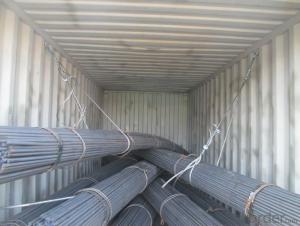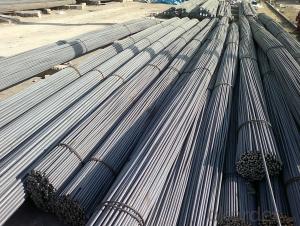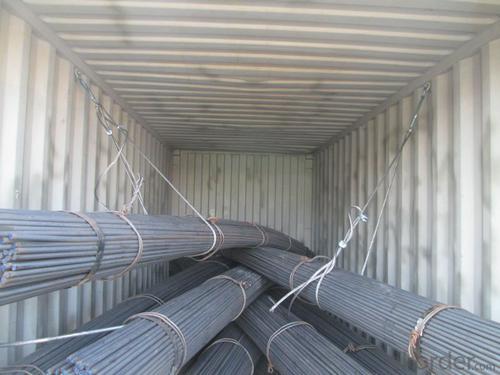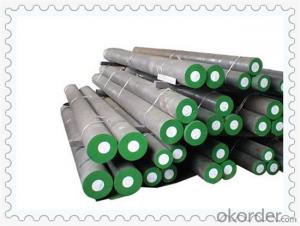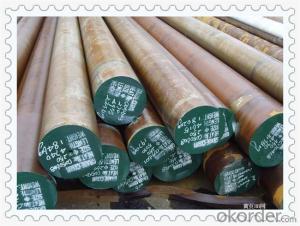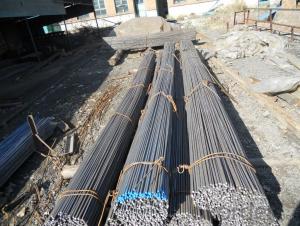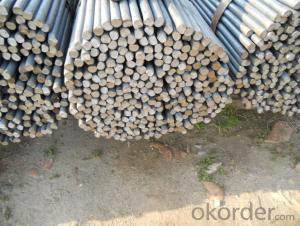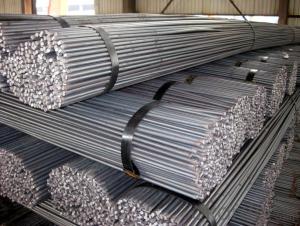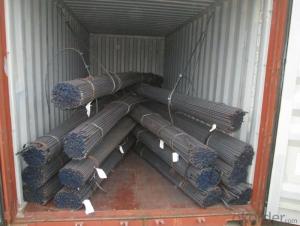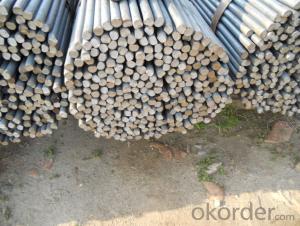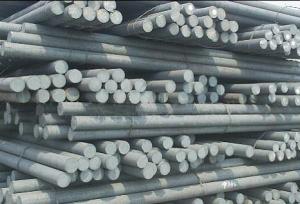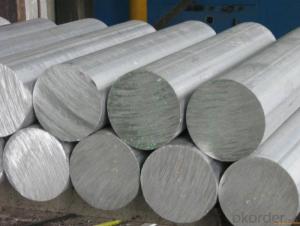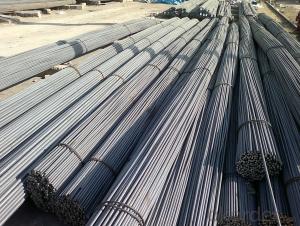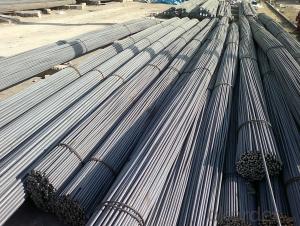Steel Round Bar Hot Rolled Made in China with High Quality for Sale
- Loading Port:
- China main port
- Payment Terms:
- TT OR LC
- Min Order Qty:
- 25 m.t.
- Supply Capability:
- 2000 m.t./month
OKorder Service Pledge
OKorder Financial Service
You Might Also Like
Specification
Product Description:
OKorder is offering Steel Round Bar Hot Rolled Made in China with High Quality for Sale at great prices with worldwide shipping. Our supplier is a world-class manufacturer of steel, with our products utilized the world over. OKorder annually supplies products to European, North American and Asian markets. We provide quotations within 24 hours of receiving an inquiry and guarantee competitive prices.
Product Applications:
Steel Round Bar Hot Rolled Made in China with High Quality for Sale are ideal for structural applications and are widely used in the construction of buildings and bridges, and the manufacturing, petrochemical, and transportation industries.
Product Advantages:
OKorder's Steel Round Bar Hot Rolled Made in China with High Quality for Sale are durable, strong, and resist corrosion.
Main Product Features:
· Premium quality
· Prompt delivery & seaworthy packing (30 days after receiving deposit)
· Corrosion resistance
· Can be recycled and reused
· Mill test certification
· Professional Service
· Competitive pricing
Packaging & Delivery:
Packaging Detail: products are packed in bundle and then shipped by container or bulk vessel, deformed bar is usually naked strapping delivery, when storing, please pay attention to moisture proof. The performance of rust will produce adverse effect.
Each bundle weight: 2-3MT, or as required
Payment term: TT or L/C
Delivery Detail: within 45 days after received advanced payment or LC.
Label: to be specified by customer, generally, each bundle has 1-2 labels
Trade terms: FOB, CFR, CIF
FAQ:
Q1: Why buy Materials & Equipment from OKorder.com?
A1: All products offered byOKorder.com are carefully selected from China's most reliable manufacturing enterprises. Through its ISO certifications, OKorder.com adheres to the highest standards and a commitment to supply chain safety and customer satisfaction.
Q2: How do we guarantee the quality of our products?
A2: We have established an advanced quality management system which conducts strict quality tests at every step, from raw materials to the final product. At the same time, we provide extensive follow-up service assurances as required.
Q3: How soon can we receive the product after purchase?
A3: Within three days of placing an order, we will begin production. The specific shipping date is dependent upon international and government factors, but is typically 7 to 10 workdays.
Images:
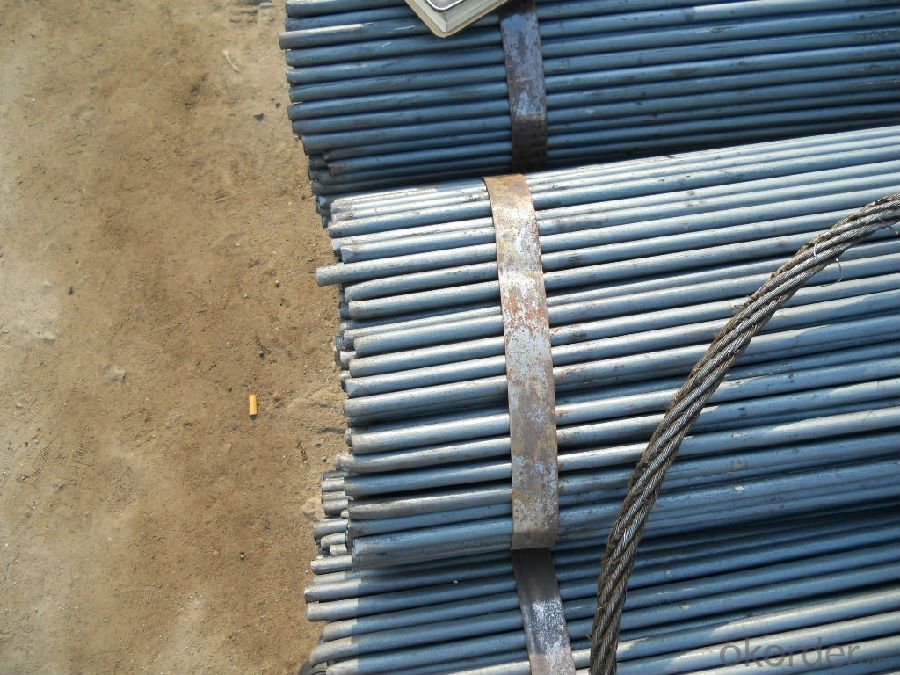
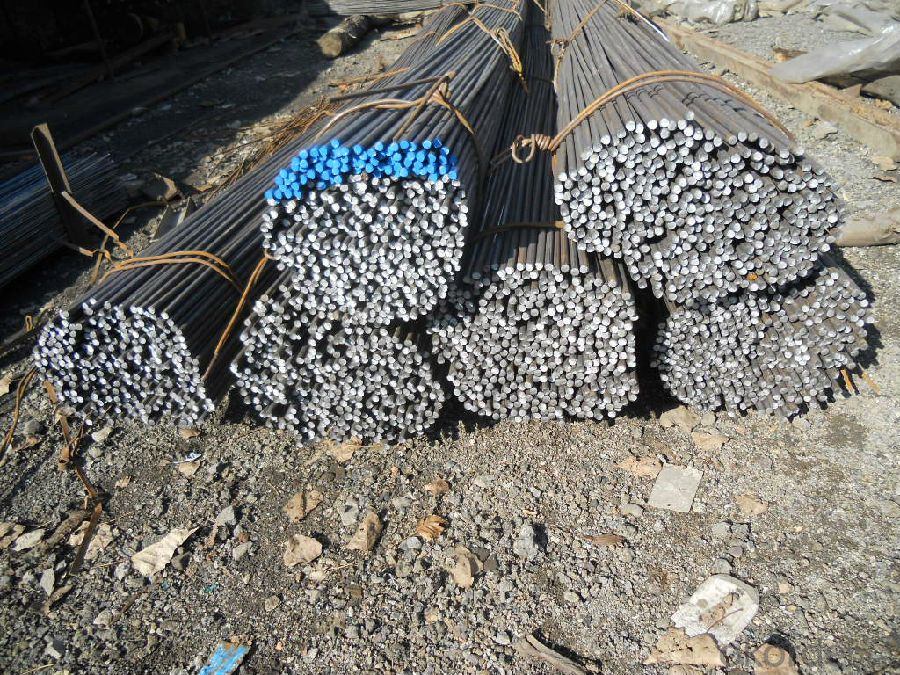
- Q: Are steel round bars resistant to corrosion?
- Yes, steel round bars are generally resistant to corrosion due to their composition which includes a significant amount of chromium. This chromium forms a protective layer on the surface of the steel, preventing rust and corrosion. However, the resistance to corrosion may vary depending on the specific grade and environment in which the steel round bars are exposed.
- Q: How are steel round bars classified based on their shape?
- Steel round bars are classified based on their shape into two main categories: hot-rolled round bars and cold-drawn round bars. Hot-rolled round bars are made by heating a steel billet until it becomes malleable and then passing it through a series of rollers to achieve the desired shape. This process results in a rougher surface texture and a slightly larger diameter compared to cold-drawn round bars. Hot-rolled round bars are commonly used in construction, engineering, and manufacturing applications where strength and durability are important. On the other hand, cold-drawn round bars are made by pulling a hot-rolled round bar through a series of dies at room temperature. This process improves the dimensional accuracy, surface finish, and mechanical properties of the steel. Cold-drawn round bars have a smoother surface texture and a more precise diameter, making them suitable for applications that require tight tolerances, such as precision machining, automotive components, and shafts for machinery. In summary, the classification of steel round bars based on their shape is determined by the manufacturing process used. Hot-rolled round bars are rougher and slightly larger in diameter, while cold-drawn round bars have a smoother surface texture and more precise dimensions. The choice between these two categories depends on the specific requirements of the application.
- Q: Can steel round bars be used in the production of musical instruments?
- Certainly! Musical instruments can indeed be produced using steel round bars. Steel, being a versatile material, possesses a wide array of desirable attributes including strength, durability, and resonance. Although wood is typically the go-to material for crafting musical instruments, steel can be utilized in specific instances to augment the instrument's sound and performance. For instance, steel round bars can be implemented in the fabrication of various components such as keys or valves for wind instruments like saxophones or trumpets. Moreover, these bars can be employed to construct the internal support systems in instruments like guitars or cellos, thereby providing stability and enriching tonal qualities. Furthermore, steel round bars can be employed in the construction of percussion instruments such as steel drums or xylophones, where their robust and resonant attributes are highly sought after. On the whole, although wood remains the more prevalent choice in the realm of musical instrument production, steel can certainly be employed in specific scenarios to attain desired sound characteristics and structural integrity.
- Q: Are steel round bars used in the aerospace industry?
- Yes, steel round bars are commonly used in the aerospace industry for various applications such as structural components, landing gears, and engine parts. The high strength, durability, and excellent mechanical properties of steel make it an ideal material choice for aircraft manufacturing.
- Q: How do steel round bars compare to wrought iron bars?
- Steel round bars and wrought iron bars have several differences that set them apart. Firstly, steel round bars are made from an alloy of iron and carbon, whereas wrought iron bars are composed of pure iron with a low carbon content. This difference in composition leads to varying properties. Steel round bars are known for their strength and durability, making them suitable for a wide range of applications, including construction, manufacturing, and engineering. On the other hand, wrought iron bars are softer and more malleable, allowing them to be easily shaped and formed into intricate designs. This characteristic makes wrought iron bars popular in decorative applications such as gates, fences, and ornamental pieces. Another difference lies in their manufacturing processes. Steel round bars are typically produced through hot rolling, which involves heating the steel billet and passing it through a series of rollers to shape it into the desired round bar form. In contrast, wrought iron bars are made through a labor-intensive process called blacksmithing. This involves heating the iron and repeatedly hammering it to remove impurities and create a fibrous structure, resulting in its characteristic grainy appearance. In terms of cost, steel round bars are generally more affordable compared to wrought iron bars. The manufacturing process for steel is more streamlined and efficient, leading to lower production costs. Wrought iron bars, on the other hand, require more time and labor, making them more expensive. Finally, when it comes to corrosion resistance, steel round bars have an advantage. Steel can be further alloyed with elements such as chromium, nickel, and molybdenum to enhance its resistance to rust and corrosion. This makes steel round bars suitable for outdoor applications where they may be exposed to moisture and harsh environmental conditions. Wrought iron bars, although they possess some level of corrosion resistance, are more prone to rusting and require regular maintenance to prevent deterioration. In conclusion, steel round bars and wrought iron bars differ in terms of composition, strength, manufacturing process, cost, and corrosion resistance. The choice between the two will depend on the specific requirements of the application, with steel round bars being favored for their strength and affordability, while wrought iron bars are often chosen for their malleability and decorative appeal.
- Q: Are steel round bars used in the aerospace industry?
- Indeed, it is common practice to employ steel round bars within the aerospace industry. Renowned for their exceptional strength, durability, and resistance to corrosion, these round bars prove themselves as an excellent choice for aircraft components and structures. They find frequent application in the creation of landing gears, engine mounts, structural frames, and other pivotal aircraft parts. Moreover, steel round bars are also utilized in the production of aerospace fasteners, such as bolts and screws, owing to their capacity to endure immense stress and establish a steadfast connection. In summary, the pivotal role played by steel round bars in guaranteeing the safety and dependability of aerospace systems cannot be overstated.
- Q: Can steel round bars be used in high temperature applications?
- Steel round bars can indeed be used in high temperature applications. However, the specific type of steel and its composition will determine its suitability for such conditions. Certain grades of steel, such as stainless steel or heat-resistant alloys, are specifically designed to withstand high temperatures without losing their strength or undergoing deformation. These steel round bars are often used in applications such as furnace components, boiler tubes, and heat exchangers, where they are subjected to extreme heat. It is crucial to select the appropriate steel grade based on the specific temperature requirements and conditions of the application to ensure optimal performance and longevity.
- Q: What is the fatigue strength of a steel round bar?
- The fatigue strength of a steel round bar refers to its ability to withstand repeated loading and unloading cycles without experiencing failure. It is a measure of the maximum stress that the bar can endure without developing cracks or fractures due to fatigue. The fatigue strength of a steel round bar depends on various factors such as the material composition, surface condition, size, and manufacturing process.
- Q: What are the environmental impacts of steel round bar production?
- The production of steel round bars has several environmental impacts. Firstly, the extraction of raw materials such as iron ore and coal required for steel production leads to habitat destruction, deforestation, and disruption of ecosystems. Mining activities also generate large amounts of waste, including tailings and waste rock, which can contaminate soil, water bodies, and air. The process of converting iron ore into steel involves high energy consumption, primarily from fossil fuels. The burning of these fuels releases greenhouse gases, such as carbon dioxide and nitrogen oxides, contributing to climate change and air pollution. Additionally, steel production releases particulate matter, sulfur dioxide, and other pollutants that can have detrimental effects on human health and ecosystems. Steel manufacturing also requires significant amounts of water for cooling, cleaning, and processing. This can lead to water scarcity and pollution if proper water management practices are not in place. Discharge of untreated or inadequately treated wastewater from steel production can contaminate nearby water sources, affecting aquatic life and potentially harming human populations who rely on these water bodies. Furthermore, the transportation of raw materials and finished steel products over long distances contributes to carbon emissions and air pollution. The energy-intensive nature of steel production and transportation further exacerbates the overall environmental impacts of the industry. To mitigate these environmental impacts, the steel industry has been implementing various measures. These include the use of more efficient technologies, such as recycling and minimization of waste, improving energy efficiency, and adopting cleaner production processes. Additionally, the industry has been focusing on reducing its carbon footprint by increasing the use of renewable energy sources and implementing carbon capture and storage technologies. Overall, while steel round bar production contributes to environmental degradation, there are ongoing efforts within the industry to minimize its negative impacts and transition towards more sustainable practices.
- Q: How do steel round bars compare to glass round bars?
- Steel round bars and glass round bars differ in terms of their properties and applications. Here's a comparison: Strength and Durability: Steel round bars possess exceptional strength and durability, with a high tensile strength that allows them to withstand heavy loads and pressure without deformation. Conversely, glass round bars are fragile and easily break under stress or impact, making them unsuitable for structural applications where strength is crucial. Weight: Steel round bars are considerably heavier than glass round bars. Although this can be advantageous in applications requiring stability and support, it can be a disadvantage in situations where lightweight materials are desired. Corrosion Resistance: Steel round bars are susceptible to corrosion when exposed to moisture or harsh environments. However, they can be safeguarded by coatings or alloys that enhance their resistance to corrosion. In contrast, glass round bars are not prone to corrosion, making them an ideal choice in corrosive environments. Transparency and Aesthetics: Glass round bars have the advantage of transparency, making them suitable for decorative purposes or applications where visibility is important. On the other hand, steel round bars are opaque and lack this characteristic. Thermal Conductivity: Steel round bars have higher thermal conductivity compared to glass round bars. This property makes them more suitable for applications requiring heat transfer or dissipation. Cost: Steel round bars are generally more affordable than glass round bars. The production processes and limited availability of specialized glass types contribute to the higher cost of glass round bars. In conclusion, steel round bars are favored for their strength, durability, and cost-effectiveness, making them suitable for structural applications. Conversely, glass round bars offer transparency, aesthetic appeal, and corrosion resistance, making them suitable for decorative or specific applications where visibility is important. Ultimately, the choice between the two materials depends on the specific requirements and constraints of the project at hand.
Send your message to us
Steel Round Bar Hot Rolled Made in China with High Quality for Sale
- Loading Port:
- China main port
- Payment Terms:
- TT OR LC
- Min Order Qty:
- 25 m.t.
- Supply Capability:
- 2000 m.t./month
OKorder Service Pledge
OKorder Financial Service
Similar products
Hot products
Hot Searches
Related keywords
